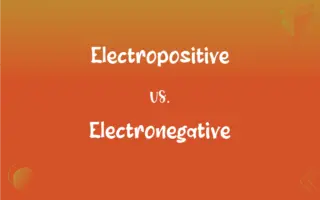Adenosine vs. Deoxyadenosine: What's the Difference?
Edited by Aimie Carlson || By Janet White || Published on January 19, 2024
Adenosine is a nucleoside important in energy transfer, while deoxyadenosine is its deoxyribose-containing variant, essential in DNA structure.

Key Differences
Adenosine is a nucleoside composed of an adenine base attached to a ribose sugar, playing a crucial role in cellular energy transfer, neurotransmission, and signal transduction. Deoxyadenosine differs by having a deoxyribose sugar instead of ribose, making it a fundamental component of DNA, where it pairs with thymine.
In the body, adenosine functions in various biochemical processes, including as a building block of RNA and as part of ATP, the primary energy carrier in cells. Deoxyadenosine is integral in DNA, dictating genetic information and involved in processes like replication and repair.
Adenosine is involved in metabolic pathways related to energy transfer and modulation of neurological activity, and can be metabolically converted to other nucleotides. Deoxyadenosine metabolism is closely tied to DNA synthesis and repair, and imbalances can lead to genetic disorders.
Medically, adenosine is used in pharmacology for heart rhythm normalization and as a diagnostic tool in stress tests. Deoxyadenosine, when altered, is associated with certain genetic conditions and is a target in chemotherapy treatments.
Adenosine occurs naturally in cells and is synthesized through metabolic pathways like the adenine salvage pathway. Deoxyadenosine is primarily formed during DNA synthesis and repair and is less prevalent in its free form in cells compared to adenosine.
ADVERTISEMENT
Comparison Chart
Sugar Component
Ribose
Deoxyribose
Role in Biochemical Processes
Energy transfer, RNA building block
DNA structure, genetic information
Key Biological Functions
Cellular energy transfer, neurotransmission
DNA replication and repair
Medical Applications
Heart rhythm regulation, diagnostic tool
Target in genetic disorder treatment, chemotherapy
Metabolic Pathways
Part of ATP, involved in various metabolic pathways
Tied to DNA synthesis and repair
ADVERTISEMENT
Adenosine and Deoxyadenosine Definitions
Adenosine
A nucleoside important in energy transfer.
Adenosine triphosphate (ATP) is crucial for cellular energy.
Deoxyadenosine
A DNA nucleoside containing deoxyribose.
Deoxyadenosine pairs with thymine in DNA.
Adenosine
Used in medical treatments.
Adenosine is administered to manage certain heart conditions.
Deoxyadenosine
Integral in genetic information coding.
Deoxyadenosine is a key component in genetic sequences.
Adenosine
Component of RNA.
Adenosine forms part of the RNA structure.
Deoxyadenosine
Associated with certain genetic disorders.
Abnormalities in deoxyadenosine metabolism can lead to diseases.
Adenosine
Involved in cellular signaling.
Adenosine modulates heart rate and neurological functions.
Deoxyadenosine
Involved in DNA replication and repair.
Deoxyadenosine plays a role in DNA synthesis.
Adenosine
A building block in various biochemical pathways.
Adenosine's role extends to multiple metabolic processes.
Deoxyadenosine
Targeted in chemotherapy treatments.
Some drugs target deoxyadenosine pathways in cancer therapy.
Adenosine
A nucleoside, C10H13N5O4, that is composed of adenine linked to ribose, is a component of nucleic acids and of ADP, AMP, and ATP, and plays a role in regulating various physiological functions.
Deoxyadenosine
(biochemistry) A deoxyribonucleoside related to adenosine
Adenosine
A nucleoside derived from adenine and ribose, found in striated muscle tissue.
Deoxyadenosine
A nucleoside component of DNA; composed of adenosine and deoxyribose
Adenosine
(biochemistry) a nucleoside that is a structural component of nucleic acids; it is present in all living cells in a combined form as a constituent of DNA and RNA and ADP and ATP and AMP
FAQs
Can adenosine affect heart function?
Yes, it's used to regulate heart rhythm in medical settings.
Is adenosine involved in neurotransmission?
Yes, it plays a role in neurological signaling.
How does deoxyadenosine contribute to genetics?
It's a key part of DNA, encoding genetic information.
What role does deoxyadenosine play in chemotherapy?
It's targeted by certain drugs to disrupt cancer cell DNA.
Is adenosine found in DNA?
No, adenosine is a component of RNA, not DNA.
Can adenosine levels affect sleep?
Yes, adenosine accumulation is linked to sleep regulation.
How is deoxyadenosine formed in cells?
It's synthesized during DNA replication and repair.
What is adenosine's primary function in cells?
It's crucial in energy transfer and as an RNA component.
Can deoxyadenosine be used in genetic research?
Yes, it's vital in studying DNA structure and function.
Does adenosine have a role in stress tests?
Yes, it's used diagnostically in cardiac stress tests.
Does deoxyadenosine affect cell division?
Yes, it's crucial in the process of DNA replication during cell division.
Are there specific diseases linked to deoxyadenosine?
Yes, certain metabolic disorders are linked to its dysregulation.
Can adenosine cause side effects when used medically?
Yes, it can cause brief side effects like flushing or chest discomfort.
Does deoxyadenosine pair with adenine?
In DNA, deoxyadenosine pairs with thymine.
What happens if deoxyadenosine metabolism is disrupted?
It can lead to genetic disorders and DNA synthesis problems.
What dietary sources contain adenosine?
Adenosine is synthesized in the body and not directly sourced from diet.
Is adenosine a drug target for any conditions?
Yes, it's targeted in conditions like arrhythmias and certain neurological disorders.
How is adenosine cleared from the body?
It's metabolized and broken down by various enzymes.
What is the significance of deoxyadenosine in forensics?
Its analysis can be used in DNA profiling and forensic investigations.
How do enzymes differentiate between adenosine and deoxyadenosine?
Enzymes recognize the sugar component difference between them.
About Author
Written by
Janet WhiteJanet White has been an esteemed writer and blogger for Difference Wiki. Holding a Master's degree in Science and Medical Journalism from the prestigious Boston University, she has consistently demonstrated her expertise and passion for her field. When she's not immersed in her work, Janet relishes her time exercising, delving into a good book, and cherishing moments with friends and family.
Edited by
Aimie CarlsonAimie Carlson, holding a master's degree in English literature, is a fervent English language enthusiast. She lends her writing talents to Difference Wiki, a prominent website that specializes in comparisons, offering readers insightful analyses that both captivate and inform.






































































